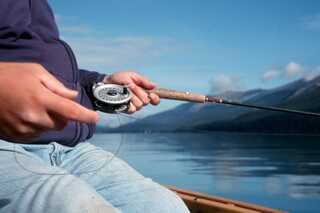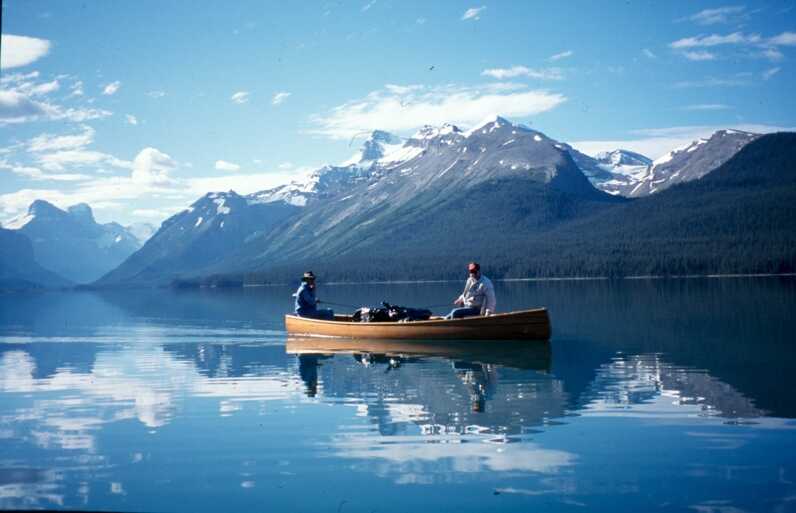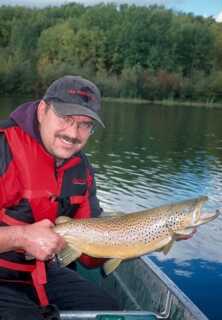Get it deep, keep it on the bottom and catch a fish. That's often the formula for fishing success and for good reason. Much of what a fish eats lives on or near bottom. There are multitudes of presentations that accomplish this 'get it deep' idea, but one of my favorites is using a flyrod and leadcore line. The beauty behind this is mobility. I can troll this presentation, covering water, getting my lure or fly in front of more fish.


Fishing leadcore wasn't something I came up with though. I thought that leadcore line was tough to manage and a burden on angler and fish. I was wrong. Leadcore line is supple. It can not be cast, because it does have a tendency to kink, but it can be trolled and when it's trolled, it's an all-star. When trolled, leadcore line effectively delivers my presentation deep, in a hurry. I have fished forty and fifty feet of water and caught bottom with my fly.


My good friends Kavin Barker and Trevor McLeod first showed me the beauty of the leadcore rig and it's effectiveness. We were fishing for rainbows and brook trout. We rigged our rods so there was a large streamer or nymph like fly on the end, tied to about 20 feet of leader, which was tied to the leadcore. We'd set a trolling speed fairly slow with the electric motors and periodically pump our rods for added action.
Beyond that, we varied our speed from a dead crawl to slightly faster. The idea was to give those trout lots of time to look over the fly and decide whether or not to hit. Well, many did. In fact we've lost count of how many we caught, but it was a bunch. I've since taken the leadcore show on the road and fished numerous pothole trout lakes near and far with similar success. Be it browns, rainbows or brookies, they've all responded favorably to the presentation.




My favorite flies when it comes to using leadcore are the larger, eat it or beat it varieties. A large full back nymph, bead head wooly bugger or one of my favorites but hard to come by, double shrimp patterns will all put fish in the boat.
The trick isn't so much in whether a fish will bite, for most do. The trick is in finding the depth and the speed that will trigger the bite. I believe that trout eat in response to their metabolism. When water temperatures are favorable, which is slightly cool, they eat aggressively and a faster presentation works wonders. But when water temperatures are downright cold, the presentation needs to be keyed down a notch to match their mood. This is where an electric motor shines, cause you can bring the speed down to a crawl and still catch fish.
So the question becomes, where do I fish when I plunk my boat in? My answer is to start at the deep edges of weedbeds and points and work out deeper from there. Because leadcore sinks like a rock, fishing anything less than about 8 feet is near impossible. Usually fishing the deep edges of the outside weedbeds will put me eight to ten feet down. Because it's an edge, there are likely to be fish hanging out too. It's a good combination. From there, I'll zig zag the boat deeper and shallower and let the fish tell me what they want and where.


But in the heat of the summer, sometimes a trout will need to go deeper to stay cool. This is especially true for the larger fish. They'll take to suspending over deep water in that area of rapid temperature transition called the thermocline. This thermocline could be 10, 12, 15 or more feet down. This is where leadcore shines and the reason it does is because it's colored. Every ten yards of leadcore is a different color. There are reds, blues, greens and whatnot. So with no knowledge of how deep the fish are, I'll start fishing by pulling out one color of leadcore off the reel. If there are no bites, I'll go a color and a half, then two and so on until I get hits. When I do, I know exactly how much line to pull out to put me right back into the good fishing.


This technique during the summer is magic. My buddy Ross Stout and I fished a local pothole in the heat of a plus 30-degree summer day. Nearly every pass all day long one or both of us lit up a big rainbow. We were down two colors and could do no wrong. Two to four pound trout were everywhere and the fishing was a fast and furious as we've ever had it. All thanks to leadcore, long leaders and big flies.



